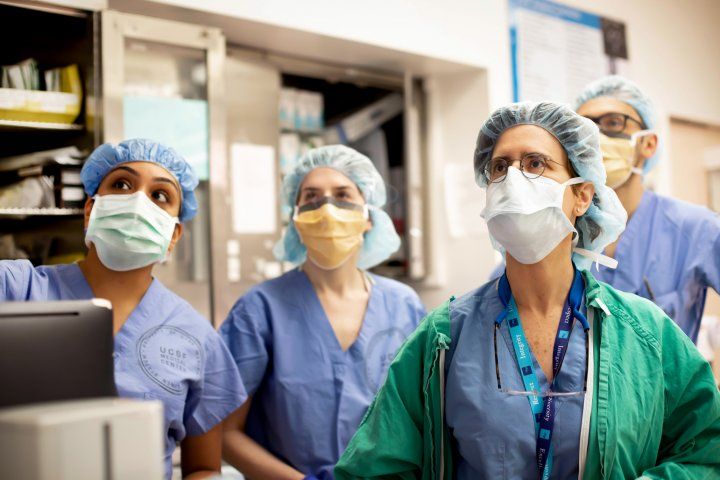Mask-Wearing Reduces Face-Touching Among Health Care Providers

Monica Jain, MD, front left, clinical fellow in Endocrine Surgery, and Julie Ann Sosa, MD, MA, FACS, front right, chair of Surgery, with medical students. Photo by Susan Merrell
Health care practitioners who wore masks touched their faces significantly less often than practitioners who did not wear masks, according to a new study led by Robert Goldsby, MD, a UC San Francisco professor of clinical pediatrics.
Among a group of 40 health care professionals observed by the study authors, those without masks touched their faces nearly four times as often as those who wore masks, indicating that masks not only are an effective barrier to disease transmission, but also may reduce face-touching, at least among health care professionals.
“In the middle of the COVID-19 pandemic, this is a timely issue,” said Goldsby, a pediatric cancer specialist at UCSF Benioff Children's Hospitals. “Our study, while limited, addresses a potential misconception that masks increase face-touching behavior. There is no evidence that masks increase face touching, and in fact our data suggest otherwise.”
For the study, which published online in Pediatric Blood and Cancer on July 1, 2020, the researchers monitored and recorded face-touching among a group of nurses, social workers, residents, fellows and attending physicians who were attending a meeting in a hospital conference room. Twenty-four wore masks most of the time and 16 did not.
The study found that those who wore masks touched their faces a median of 5.4 times an hour, while those who did not wear masks touched their faces a median of 20 times an hour.
“Health care professionals may be used to wearing masks and this may, in part, explain why they touch their faces less often with a mask on,” said Goldsby. “Also, if this is true, perhaps as the general public use masks more often, they too may touch their faces less often with a mask.”
However, the study also found that health professionals’ perception of face-touching was different than what the team observed. As part of the study, the researchers sent a one-question anonymous survey to 187 health care providers asking, “When you are wearing a mask, do you feel like you touch your face: less often than you do without a mask; same frequency as you do without a mask; more often than you do without a mask?”
Of the 131 who responded, 48 (37 percent) felt they touched their faces less often with a mask, 49 (37 percent) felt they touched their faces more often and 34 (26 percent) thought wearing a mask made no difference.
“It’s interesting that even among health professionals, a large number thought that wearing a mask would encourage face-touching,” said Goldsby. “In fact, I shared that belief. However, our study showed my perception to be wrong.”
The study authors note that in the United States, public health messages about wearing masks have been inconsistent. Before April 3, 2020, guidance from the Centers for Disease Control (CDC) was that people did not need to wear masks unless they were sick. On April 3, the CDC changed that guidance to recommend that all people wear face coverings in public areas.
“Recent data have shown that masks, along with hand washing, are very important in reducing COVID-19 transmission,” said Goldsby. “It’s important that we dispel myths about face masks.”
The authors caution that the small number of individuals observed and the limited time they were observed may have biased the results. After the study was conducted, the hospital mandated mask-wearing at all times, which prevented the collection of additional comparable data.
Coauthors of the study are Tiffany Lucas, MD, a UCSF assistant professor of pediatrics and Rachel Mustain of the UCSF Helen Diller Comprehensive Cancer Center.